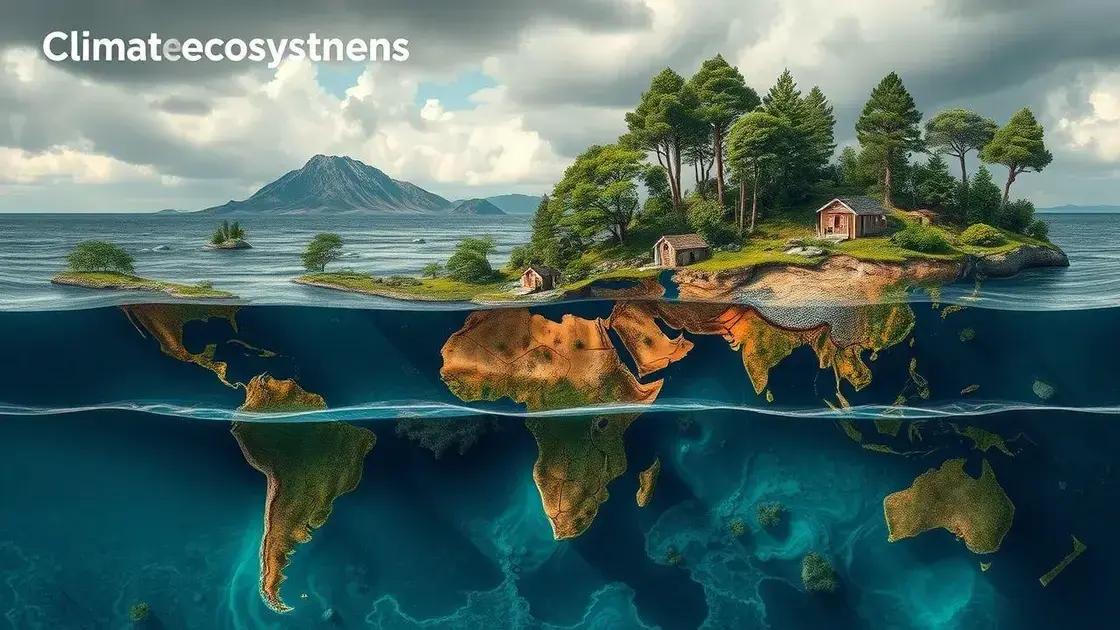Foot climate change report: what you need to know

Individuals can contribute to combating climate change by practicing energy conservation, adopting sustainable transportation, reducing waste through recycling, and advocating for environmental policies.
In the foot climate change report, critical insights are shared that could influence our approach to environmental challenges. Are you aware of how these findings might affect your community and the planet? This article dives into the essential points that everyone should know.
Understanding the foot climate change report
The foot climate change report provides essential insights into how climate change affects our planet. Understanding this report can greatly influence our actions and policies moving forward. Let’s explore its main components.
Key Aspects of the Report
Firstly, the report dives into pivotal data regarding temperature changes and their consequences. It underscores how rising global temperatures have led to drastic environmental shifts. These changes impact not just wildlife but also human communities worldwide.
Critical Findings
- The increase in average temperatures is directly linked to human activity.
- Melting ice caps are contributing to rising sea levels.
- Extreme weather events are becoming more frequent and severe.
- Local ecosystems are facing unprecedented stress and alterations.
Moreover, the report emphasizes the need for immediate action. This isn’t just a future problem; it’s a current reality that we must tackle together. Every degree counts, and it’s essential that we comprehend the implications.
As temperatures continue to rise, the effects can be felt in numerous aspects of daily life. Communities in coastal regions face flooding threats, while agricultural zones struggle with altered weather patterns. It’s a multifaceted crisis that demands a multifaceted response.
Why Understanding This Report Matters
Recognizing the importance of the foot climate change report means acknowledging that our decisions today shape tomorrow. Engaging with the findings allows us to advocate for policies that promote sustainability and protect our ecosystems. By educating ourselves, we empower communities to take actionable steps.
In summary, grasping the contents of the report is an integral part of confronting climate change. The challenge is significant, but awareness is the first step toward making a meaningful difference.
Key findings from the latest report
The latest report on climate change presents several key findings that everyone should understand. These insights highlight not only the urgency of the situation but also the critical changes happening worldwide.
Major Temperature Increases
Data from the report reveals that global temperatures have increased significantly over the past few decades. This warming is primarily caused by human activities, such as burning fossil fuels and deforestation. As a result, we are witnessing a range of effects that can alter ecosystems and weather patterns.
Impact on Weather Patterns
- More frequent and intense heatwaves.
- Increased rainfall leading to flooding in some areas.
- Extended droughts affecting agricultural productivity.
- Higher instances of severe storms and hurricanes.
These changes not only impact nature but also human lives. Communities are facing tougher challenges due to these unpredictable weather conditions, resulting in economic and social stress.
Additionally, the report emphasizes the melting of ice caps and glaciers. This phenomenon contributes to rising sea levels, which threaten coastal cities and ecosystems. As polar regions warm, the habitats of various species are also at risk, making biodiversity preservation more critical.
Health and Economic Consequences
The health of populations is increasingly at risk due to these climate changes. Heat-related illnesses are rising, and extreme weather can disrupt food supplies. By understanding the correlations highlighted in the report, communities can prepare and adapt better to mitigate these risks.
Furthermore, the economic impact is profound. Industries reliant on natural resources, such as agriculture and fishing, face unstable conditions that can lead to decreased yields. Investing in sustainable practices is essential for future resilience.
Impacts of climate change on local ecosystems

The impacts of climate change on local ecosystems are profound and far-reaching. As temperatures rise, many species are facing serious challenges to their survival. Understanding these changes is crucial for protecting biodiversity and ensuring a healthy planet.
Altered Habitats
One major impact of climate change is the alteration of natural habitats. As temperatures increase, some ecosystems may shift to new locations. For instance, forests may migrate to higher elevations, while wetlands can expand or contract based on rainfall patterns. These changes can lead to mismatches between species and their habitats, putting wildlife at risk.
Species Threats
- Invasive Species: Warmer temperatures allow invasive species to thrive, often outcompeting native plants and animals.
- Endangered Species: Many threatened species struggle to adapt to the rapid changes, leading to increased extinction risks.
- Food Web Disruptions: Changes in one species can have ripple effects, disrupting the entire food web.
- Pollinator Declines: Many pollinators are sensitive to temperature changes, affecting plant reproduction.
These threats underscore the delicate balance within ecosystems. For example, the decline of pollinators, such as bees, can severely affect agriculture and local food supplies. Similarly, the decline of fish populations in warming waters can impact both ecosystem health and local economies that rely on fishing.
Moreover, climate change alters water sources, affecting not just aquatic ecosystems but terrestrial ones as well. Rivers and lakes may experience fluctuations in temperature and level, which impact the organisms that depend on them for survival. Amphibians and certain fish are particularly vulnerable to these changes.
Adaptive Strategies
Faced with these challenges, many species are beginning to adapt. Some may migrate to cooler areas, while others change their behaviors or reproductive patterns. However, the speed of climate change often outpaces these natural adaptations, leading to significant losses in biodiversity.
It is essential that we take action to mitigate these impacts. Conservation efforts can help protect vulnerable species and restore compromised habitats. By understanding the impacts of climate change on local ecosystems, we can develop more effective strategies to combat these threats and preserve our natural world.
Strategies recommended in the report
The report on climate change outlines several strategies that can help mitigate the impacts of this global crisis. Implementing these strategies is essential for communities, governments, and individuals alike.
Renewable Energy Transition
One of the main recommendations is to transition to renewable energy sources. This shift is crucial to reduce greenhouse gas emissions. Options like solar, wind, and hydroelectric power can significantly decrease reliance on fossil fuels.
Energy Efficiency Improvements
- Building Codes: Implementing stricter building codes can ensure energy-efficient designs in new structures.
- Upgrading Infrastructure: Retrofitting older buildings with modern insulation and energy-efficient systems can reduce consumption.
- Smart Technologies: Incorporating smart technologies in homes can help monitor and manage energy use effectively.
- Public Transportation: Investing in public transportation systems reduces the number of vehicles on the road, lowering emissions.
Enhancing energy efficiency not only helps the environment but also saves money on energy bills. By making these improvements, communities can lead the way in sustainability.
Conservation and Restoration Efforts
Another critical strategy involves conservation and restoration of natural habitats. Protecting forests, wetlands, and coral reefs maintains ecosystems and enhances their resilience to climate change. Healthy ecosystems provide vital services, such as carbon sequestration and flood protection.
Community Engagement and Education
Engaging the community through education and outreach can drive collective action. Workshops and programs on sustainability can empower individuals and families to make informed choices. When communities understand the impacts of their actions, they can take steps to reduce their carbon footprint.
Ultimately, implementing the strategies recommended in the report requires collaboration among governments, businesses, and the public. By embracing these recommendations, we can overcome challenges posed by climate change and create a sustainable future.
How individuals can contribute to change
Individuals play a vital role in combating climate change. By making small adjustments in our daily lives, we can collectively make a significant impact. Understanding how we can contribute to change is essential for a sustainable future.
Practice Energy Conservation
One effective way to reduce your carbon footprint is by conserving energy at home. Simple actions, such as turning off lights when they are not needed and unplugging devices, can save energy. Additionally, using energy-efficient appliances helps minimize energy consumption.
Adopt Sustainable Transportation
- Public Transport: Using public transportation reduces the number of cars on the road, which lowers emissions.
- Biking or Walking: For short distances, consider biking or walking instead of driving.
- Carpooling: Sharing rides with others lessens the environmental impact of driving alone.
- E-Vehicles: If possible, switch to electric or hybrid vehicles to decrease reliance on fossil fuels.
By adopting sustainable transportation methods, individuals can help reduce air pollution and lower greenhouse gas emissions.
Reduce, Reuse, Recycle
Another way to contribute to change is through mindful consumption. By reducing waste, reusing items, and recycling materials, we can minimize our environmental impact. Small actions, such as carrying reusable bags or using a refillable water bottle, help keep plastics out of landfills.
Moreover, purchasing products made from recycled materials supports a circular economy. Supporting local businesses that prioritize sustainability can also make a difference.
Advocate for Change
Individual actions can be amplified through advocacy. Joining or supporting local environmental groups brings communities together to push for policy changes. Educating others about climate change can foster awareness and inspire action.
Lastly, voting for leaders and policies that prioritize environmental protection is crucial. Every voice matters, and collective advocacy can create significant change at local and national levels.
In conclusion, addressing climate change requires collective effort, and individuals play a crucial role. By adopting sustainable practices, advocating for change, and educating others, we can contribute significantly to our planet’s health. Every small action matters, and when we all join together, our combined efforts can lead to a brighter and more sustainable future.
FAQ – Frequently Asked Questions about Climate Change and Individual Actions
How can individuals effectively reduce their carbon footprint?
Individuals can reduce their carbon footprint by conserving energy, using public transport, and making sustainable choices in their daily lives.
What are some simple ways to practice recycling at home?
You can recycle by separating waste materials like paper, plastic, and glass, using recycling bins, and participating in local recycling programs.
Why is advocacy important in combating climate change?
Advocacy raises awareness and pushes for policies that support environmental protection, empowering communities to contribute to significant change.
What are the benefits of using renewable energy sources?
Using renewable energy sources reduces greenhouse gas emissions, lowers energy costs over time, and decreases reliance on fossil fuels.






